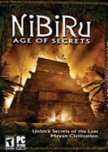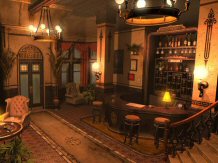In ancient Sumeria,
astronomers recorded the existence of a planet called Nibiru,
thought to be the home of a powerful alien race. The Sumerian
astronomers speculated that the inhabitants of Nibiru might choose
to live among the people of Earth as gods, building elaborate
monuments and handing down their advanced cultural and scientific
knowledge.
In time, as centuries passed, Nibiru faded into the obscurity of
myth, its light no longer identifiable in the nighttime sky.
Nibiru: Age of Secrets opens as Martin Holan receives a
telephone call from his Uncle Francois, an archaeologist nearing the
end of a distinguished career. Uncle Francois still has his finger
on the pulse of the archaeological world, and he has picked up
startling news from a friend working for the Central City Archive in
Prague. Uncle Francois decides to send Martin to meet this friend,
Barbora Kanska. You take on the role of Martin, thrilled to leave a
tedious job for more adventurous work. By the time he arrives in
Prague, night has fallen on the rendezvous point, Barbora has
departed, and Martin must search for her and for the clues to the
mystery she had sought to reveal.
You will Meet a Dark, Handsome, Strange Environment…
Nibiru: Age of Secrets is a point-and-click mystery
adventure set in exotic locations and played from a third person
perspective. This player’s first reaction was sheer astonishment at
the beauty and detail of the graphics. Those who have played Black
Mirror (by the same developers) will remember the graphical style –
Nibiru’s graphics resemble those of Black Mirror, except more
jaw-dropping.
The settings in Nibiru are photorealistic, the perspective
is just right, the composition of each screen is balanced and never
humdrum -- often scenes are viewed from unexpected angles. The
branches and leaves on trees show just the right amount of
randomness and variation to make them life-like. The light
pearlizes surfaces, then is diffused, throwing graduated shadows.
Each scene contains animations – a tram running along a side street,
a tourist strolling across a bridge. The detail is ridiculously
good.
My only graphical criticism is that in very dark locations, some
of the shadows look gray rather than black. However, so much
attention has been poured into the details, that I can’t help
wondering if this isn’t a fault of my video card rather than the
game.
I’m Not a Mule, You Know
Populating these environments is a cast of lively characters whom
Martin meets as he works his way deeper into Nibiru’s mix of
long buried secrets, obsession and intrigue. My favorite characters
were the guitar-playing street hobo, the tipsy theater troupe
director, and Pedro, Martin’s archaeological assistant (the one
who’s not a mule). Visually, the characters are nicely detailed,
and character movement is smooth if somewhat repetitive. The only
exception to this is Martin himself, who seems a trifle stiff when
he moves. Lip synch is almost nonexistent -- not surprising in a
game that was written to be produced in several languages. The lack
of lip synch is easily overlooked because conversations rarely take
place using a close-up view.
Voice acting in the game ranges from acceptable to good. Some of
the European characters have standard Hollywood-type foreign
accents. This wasn’t particularly bothersome to me, but to someone
who has actually lived in Czechoslovakia or France, the accents will
sound inauthentic.
The actor who voices Martin Holan does a good job, with effective
inflection and expression in his voice. The character’s voice does
sound less smooth than one would expect from his appearance – but
then a young American with a French uncle and a Czech education
might plausibly be a somewhat amalgamated chap. I think it would
have added considerably to the game to know more about Martin’s
background, as I found it difficult at first to feel a connection to
him. Nevertheless, by game’s end I did feel as though I had begun
to understand his character, after having watched the way he
beguiles, manipulates and outfoxes people, not to mention the way he
manages to escapes from clever death traps and other fiendish
machinations.
Listen to This…
Dialog in Nibiru is engaging, fun to listen to, and well
paced. You should be aware that the characters do occasionally use
expletives for emphasis. If you want to take charge of the
conversation, you can click through dialogs or adjust the subtitle
speed in the Options menu. The subtitles are helpful -- though if
you’re a stickler about typographical errors, be prepared to wince.
Ambient sounds in Nibiru are impressively realistic.
There is not a great deal of background music in the game. Usually
the music only surfaces briefly at moments of particular tension –
it adds to the atmosphere, but so subtly that you might not notice
it unless you were keeping a sharp “ear” tuned for it. There is
delicate background music when you open up certain particularly
detailed inventory items that must be studied or read -- I think the
music makes sense here, as you would otherwise be reading in
silence.
Sleeping Upright and other Oddities
The game installed and played without a glitch. Nibiru
does contain a few oddities – there are times, especially when the
scene of the action changes, when you hear Martin narrating but see
only a blank screen. These transitions would be smoother if there
were a visual representation of what was happening as the transition
takes place.
The other oddities – Martin seems uncertain as to what to call
his Uncle. Sometimes he calls him Uncle, sometimes Francois, and
sometimes Professor. Unless you are following the conversation
closely, you might become confused. One other odd moment occurs
when, at the end of a long day of adventuring, Martin collapses in
exhaustion in a comfortable hotel room, but doesn’t remove his coat
or shoes. He then proceeds to fall asleep literally sitting up.
Load times for new environments were occasionally long enough to
be noticeable, though not long enough to be annoying.
Waterloo (Or the Agony of Defeat)
The challenges in Nibiru are, for the most part, a happily
constructed lot. Often the characters in the game throw obstacles
in Martin’s way that he must overcome. The obstacles created by the
“civilized” characters tend to be less entertaining than the
obstacles created by the lowlifes, paranoid schemers and thieves.
The game is linear, but in a good way. You are restricted to a
few rooms or environments in each part of the game, so if you’re
stuck you know pretty much where you need to look or what hotspots
you need to work with. I like this much better than wandering all
over huge worlds trying to figure out what I’ve missed.
There are some pixel hunting kinds of challenges, and it is a
continual challenge to remember to right-click on everything. (I
know, this should be a no-brainer, but it is surprisingly easy to
forget.) There are inventory challenges involving creative, though
logical combinations. The inventory is especially detailed. Before
an item goes into inventory, you see it framed in a circle at the
top of the screen. Once in inventory you can examine it closely,
and each item has an identifying sound attached to it.
There are no mazes, and no sound matching challenges, but there
is a sliding tile puzzle -- one that’s on the easy side. There are
also a few timed puzzles with generous time limits. I found it
possible to die at three locations within Nibiru, though the
game returns you immediately to the moment before death takes you.
(For two of the deaths, I had to sit there doing nothing for a
stretch in order to die.)
Last of all, there are some mechanical puzzles that you fiddle
with. In this last category is the (soon to be) infamous Colored
Balls puzzle. This is the first puzzle in my eleven years of
adventure gaming that I couldn’t complete, and I was compelled to
use a saved game to get past it. (Since then, a GameBoomers member
has figured out a step-by-step solution so that a saved game is not
necessary for those as flummoxed as I.) Apparently, the puzzle is
based on a concept similar to the dastardly Rubik’s Cube. The
developers would, in my humble opinion, have been better off if they
had left old Rubik alone – or else provided a bypass for this
particular challenge.
Plot Puzzles – My Favorite
The mystery in Nibiru is complicated enough that it is
difficult to understand everything that is going on the first time
through. Fortunately, there are unlimited save slots, so once
you’ve finished the game you can return and play through the
portions that feature plot nuances and explanations. Doing this
enables the gamer to put the plot pieces and details together –
another layer of challenge in the game, and one that I particularly
enjoyed.
Nibiru’s ending is enigmatic. That is, the events are
clear, but the meaning is open to different interpretations.
Quick List for Nibiru: Secret of Ages
Third person point-and-click adventure with spectacular
graphics. Intriguing, complicated plot, walking a thin line between
history and scientific speculation. A couple of violent scenes and
a sprinkling of “mature” language. Lots of interesting characters
and character interaction. Mostly competent voice acting. The
player character cannot run, but double-clicking on the exit will
speed you to the next scene.
Inventory challenges, mechanical challenges, one Rubik’s
Cube-like challenge of the extreme hair-pulling variety. A few easy
timed puzzles. No mazes, no tone matching puzzles, one sliding tile
puzzle, one puzzle in which color discrimination is key. You can
die at three locations, but you are restored to the point
immediately preceding death.
No game glitches, unlimited save slots. Once the game is
installed, you can play it from the hard drive without having to put
the game disk in the CD drive.
Nibiru is aimed at fans of Black Mirror, and at those who
enjoy mystery adventures, archaeological discoveries and the chance
to explore some of the most dazzlingly photorealistic environments
in gaming.
Final Grade: B+
design copyright ©
2005
GameBoomers
Group

